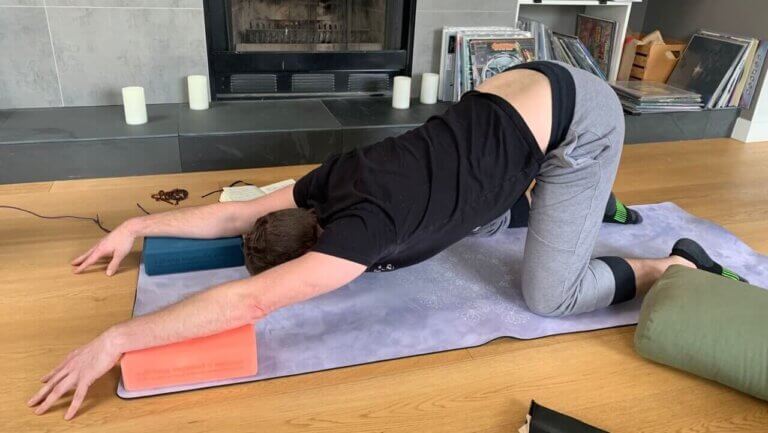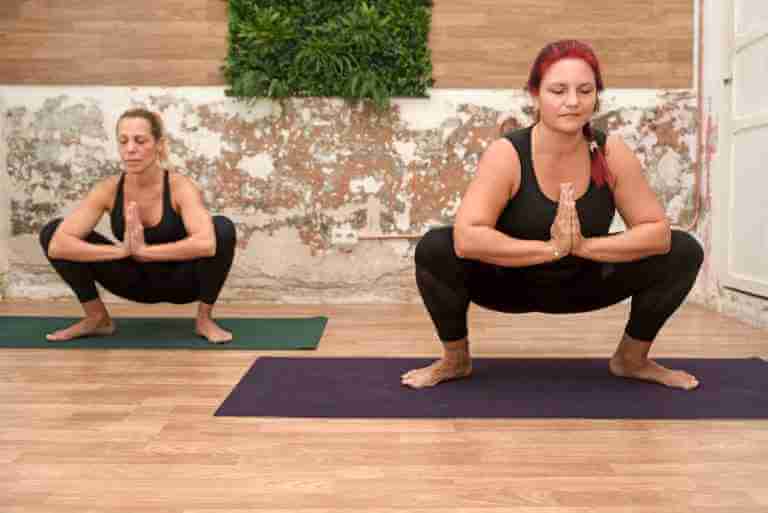Home » Yoga Blog » Yoga Poses » Anahatasana Pose: The Melting Heart Yin Yoga Pose Guide
Anahatasana Pose: The Melting Heart Yin Yoga Pose Guide
The soulful world of Anahatasana, known in English as the Melting Heart Pose, is a testament to yoga’s nurturing and healing potential Its many benefits and accessibility makes the melting heart yoga pose a staple of Yin Yoga Practices.
The Sanskrit term ‘Anahata’ denotes the heart chakra, the seat of compassion, love, and empathy, making this pose a profound expression of these attributes.
When looking into its deeper meaning, Anahatasana encourages the heart to metaphorically ‘melt’ or open. This melting of the heart allows the practitioner to experience deep emotional release and spiritual awakening. This melting heart pose represents a profound letting go of all emotional baggage, grudges, and inner turmoil.
In this Yoga Pose Article
Anahatasana Pose Benefits
Anahatasana yoga pose is a gift that keeps on giving. Its benefits range from physical to emotional and mental. Physically, it’s an excellent pose for opening the shoulders, upper back, and chest, promoting better posture and respiratory health.
The pose causes excellent compression for the upper back and mildly stresses the lower spine and shoulder/humerus joint. It also stretches the spine and stimulates the abdominal organs, aiding digestion.
Anahatasana pose is a beautiful backbend for the upper and middle back and also opens up the shoulders nicely, promoting flexibility. In addition, it softens the heart, promotes emotional healing, and contributes to mental calmness, stress reduction, and anxiety relief.
On the emotional and mental front, the melting heart pose encourages the release of stored emotions, promotes calmness, and aids in stress and anxiety reduction by fostering an environment of self-acceptance and surrender.
Regular practice of Anahatasana Pose can lead to increased emotional resilience and an enhanced capacity for empathy and compassion.
The Correct Anahatasana Pronunciation
To pronounce the sanskrit name of Melting Heart Anahatasana correctly, break it into four syllables: “A-na-ha-ta-sa-na.” The stress falls on the second syllable, the “na.”
What is and How to do the Anahatasana Pose
Step by step How to Do Anahatasana pose – the Melting Heart Pose
- Start in a table top position
- Walk your hands forward while keeping your rear above the knees.
- You will begin to bend at the hips as your arms stretch out ahead.
- Let your chest to sink toward the ground. Your forehead or chest may touch the floor. If not, consider looking at the pose variations section of this article
- Unlike Balasana (child’s pose) keep your rear elevated above the knees and not above the feet
Anahatasana pose is a beautiful balance of surrender and strength. Approach the melting heart pose slowly and mindfully as the body yields to gravity while maintaining a strong, grounded base.

Pose Contraindications: Practicing Safely
While the Melting Heart Yin Yoga Pose can be deeply therapeutic, consider these specific contraindications for safe practice.
For example, people with severe shoulder or neck injuries, high blood pressure, or pregnant women, especially in their third trimester, should avoid the melting heart pose.
If you have a bad neck, the melting heart pose could strain it. Also, be aware of any tingling in the hands or fingers! Tingling is often a sign of nerve compression; if we continue to compress it, we may permanently damage it.
Adjust the arm and hand positions, or skip the Anahatasana pose if you feel tingling. As with all yoga poses, listening to your body and avoiding any position that causes pain or discomfort is essential.
Recommended Hold Times and Comming out of Anahatasana Pose
The recommended pose hold time for Anahatasana in the Yin Yoga Practice is three to five minutes. Holding the pose longer allows a deep, meditative focus and aids in releasing connective tissues, especially around the shoulders and spine.
The extended hold in this pose also offers a unique opportunity to practice mindfulness and introspection as the practitioner surrenders and sinks deeper into this melting Heart Yin Yoga pose with each breath.
However, if you’re resting your chin on the floor, the hold may need to be shorter. Carefully watch the sensations in the neck while doing the Melting Heart Yin Yoga Pose.
To come out of Anahatasana, move back into Child’s Pose or slide forward onto your belly.
Variations, Alternatives & Options to Anahatasana Pose

For those seeking to explore the pose deeper, or to get into Anahatasana pose comfortably, various modifications and props are available to accommodate different body types and flexibility levels.
- If you have tighter shoulders, back or chest muscles use a bolster or folded blanket for support under the chest
- Find out what feels best by experimenting with the placement of your hands and arms. Place your arms stretched out in front or alongside the body.
- If your arms can’t go overhead or have shoulder pain, try moving hands further apart or bending elbows
- Flexible Yogis can try bringing the chin to the floor and looking ahead. Proceed with caution as this could strain the neck.
- If knees are uncomfortable in Anahatasana Pose place a blanket underneath them.
- Instead of top of feet to the floor, try tucking the toes under and resting your chest on a bolster.
- Try Anahatasana Pose with one arm forward at a time, resting the head on the other forearm.
- Place blocks under your forearms to stress the shoulders adding a little spice to Melting Heart Yin Yoga Pose.
You Love Yoga, We Love Yoga—Let’s Stay Connected
Get yoga tips, a little inspiration, and friendly emails—because yoga is better with friends.
Counter Yoga Poses
- Lying on your stomach can be a nice rest after Anahatasana Pose
- Because the Melting Heart Pose is a backbend, a feet and knees together version Child’s Pose (balasana) is an excellent rounded forward fold counterpose.
- Alternatively, sit on your side, bring your legs around front and do a gentle seated forward bend Caterpillar Pose (Paschimottanasana)

Anahatasana Pose vs Uttana Shishosana Pose: Understanding the Difference
While Anahatasana emphasizes opening or melting the heart and chest area, Uttana Shishosana, or the Puppy Pose, focuses more on stretching the spine and shoulders. The Melting Heart Pose, with its deeper chest and shoulder opening, can offer a more intense emotional release than the Puppy Pose.
Anahatasana Pose vs Balasana (Childs Pose)
In Melting Heart Pose (Anahatasana), the hips stay lifted. At the same time, the chest melts toward the floor, creating a deep, expansive stretch through the chest, shoulders, and upper back. This posture invites a heart-opening experience, promoting emotional release and physical openness, particularly in the upper body.
In contrast, Child’s Pose (Balasana) is more grounding, with the hips resting on the heels, allowing for a gentle stretch through the lower back, hips, and thighs. While Child’s Pose encourages a sense of relaxation and restoration, Melting Heart offers a more intense upper-body experience, intensely targeting the chest and shoulders to create a fuller expression of heart-centered openness.
Additional Insights: Meridians And Chakras
The Chakras Affected by Anahatasana Pose
Anahatasana Yin Yoga Pose intertwines with the chakras, the energy centers in our bodies. It targets two important chakras: the Anahata (Heart) Chakra and the Vishuddha (Throat) Chakra.
Anahata (Heart) Chakra

As the pose name suggests, Anahatasana primarily stimulates the Anahata, or Heart Chakra, located in the center of the chest. This chakra is associated with love, compassion, and emotional balance. By opening the heart area, Anahatasana encourages energy flow through this chakra, helping to release emotional blockages and promote a sense of peace and well-being.
Vishuddha (Throat) Chakra
The second chakra influenced by Anahatasana Pose is the Vishuddha, or Throat Chakra, which links with communication and self-expression.
As the chest and throat are stretched and opened in this pose, it encourages better energy flow through the Vishuddha Chakra, potentially enhancing one’s ability to communicate and express oneself effectively.
The alignment of these chakras brought about by practicing Anahatasana yoga poses can lead to a harmonious energy balance, contributing to overall emotional, mental, and spiritual well-being.
As you practice the melting heart pose, visualize the energy flowing through these chakras, illuminating your being with love, empathy, and self-expression.
Meridians & Organs Affected by Anahatasana Pose
Meridians, according to Traditional Chinese Medicine (TCM), are pathways in the body through which life energy, known as “qi” or “chi,” flows. Certain yoga poses, including the Melting Heart Anahatasana pose, can stimulate these pathways, affecting the associated organs.
Urinary Bladder Meridian
Anahatasana Yin Yoga Pose causes compression along the spine, stimulating the Urinary Bladder Meridian. This meridian, which runs along the back of the body, is directly linked to the urinary bladder organ and indirectly to the kidneys through the water element in TCM.
Therefore, practicing Anahatasana may support the health of the urinary system and kidney functions, such as fluid regulation.
Stomach and Spleen Meridians
If you feel the stretch in the chest while practicing the Anahatasana pose, your Stomach and Spleen meridians are being stimulated. The Stomach Meridian is associated with the intake, digestion, and distribution of food and nutrients, while the Spleen Meridian links with transforming those nutrients into energy.
Stimulating these meridians in Anahatasana pose could support digestion, nutrient absorption, and overall energy levels. In TCM, the spleen also connects to the emotions of worry and overthinking. Thus, doing a melting heart pose to stimulate this meridian could promote mental and emotional balance.
Heart and Lung Meridians
Anahatasana pose can also stimulate the Heart and Lung meridians in the arms. The Heart Meridian is associated with blood circulation and emotional states, particularly joy and happiness. The Lung Meridian is related to respiratory function and the emotions of grief and sadness.
Through the melting heart stretch and opening in the arms and chest in the Anahatasana pose, energy flow can be improved in these meridians. Therefore, it supports cardiovascular and respiratory health and promotes emotional balance and well-being.
Embracing Anahatasana Pose - the Melting Heart Pose
Anahatasana Yin Yoga Pose is a journey into the self. As we surrender in the melting heart pose, we allow our hearts to open, releasing stored tension and making space for new growth and healing.
We enhance our physical well-being through practice and cultivate greater self-awareness, compassion, and inner peace. So, unroll your yoga mat, let your heart melt in Anahatasana, and embark on a journey of self-discovery and healing.
Sources


